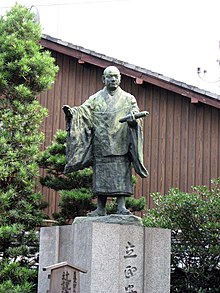 Global Information
Global InformationNichiren Buddhism information


| Part of a series on |
| Buddhism in Japan |
|---|
 |
|
| Part of a series on |
| Mahāyāna Buddhism |
|---|
 |
Nichiren Buddhism (Japanese: 日蓮仏教), also known as Hokkeshū (Japanese: 法華宗, meaning Lotus Sect), is a branch of Mahayana Buddhism based on the teachings of the 13th-century Japanese Buddhist priest Nichiren (1222–1282) and is one of the Kamakura period schools.[1]: 239 [2] Its teachings derive from some 300–400 extant letters and treatises either authored by or attributed to Nichiren.[3][4][5]
Nichiren Buddhism generally sources its basic doctrine from the Lotus Sutra claiming that all sentient beings possess an internal Buddha-nature capable of attaining Buddhahood in the current life. There are three essential aspects to Nichiren Buddhism:
- The faith in Nichiren's Gohonzon
- The chanting of Nam Myoho Renge Kyo with varying recitations of the Lotus Sutra
- The study of Nichiren's scriptural writings, called Gosho[6][7]: 225
After his death, Nichiren left to both his senior disciples and lay followers the mandate to widely propagate the Gohonzon and chanting the Daimoku in order to secure the peace and prosperity of society.[8]: 99
Traditionalist Nichiren Buddhist temple groups are commonly associated with Nichiren Shōshū and various Nichiren-shū schools. In addition, modern lay organizations not affiliated with temples such as Soka Gakkai, Kenshokai, Shoshinkai, Risshō Kōsei Kai, and Honmon Butsuryū-shū also exist while some Japanese new religions are Nichiren-inspired lay groups.[9]
The Soka Gakkai International is often called "the most prominent Japanese 'export' religion to draw significant numbers of non-Japanese converts", by which Nichiren Buddhism has spread throughout the world.[10]
Nichiren upheld the belief that the Lotus Sutra alone contains the highest degree of Buddhist teachings and proposed a classification system that ranks the quality of religions[11][12]: 128 and various Nichiren schools can be either accommodating or vigorously opposed to any other forms of Buddhism or religious beliefs. Various followers debate Nichiren status, as a Bodhisattva, a mortal saint, or an "Original Buddha" of the third age of Buddhism.[13][7][14][15] Nichiren Buddhism is practiced in many countries.[16] The largest groups are Soka Gakkai International, Nichiren Shu, and Nichiren Shōshū.[17]
- ^ Cite error: The named reference
Stone1999awas invoked but never defined (see the help page). - ^ Richard K. Payne, Re-Visioning Kamakura Buddhism (Studies in East Asian Buddhism) (Studies in East Asian Buddhism, 11), University of Hawaii Press, ISBN 978-0824820787, p. 24
- ^ Iida, Shotaro (1987). "Chapter 5: 700 Years After Nichiren". In Nicholls, William (ed.). Modernity and Religion. Wilfrid Laurier University Press. pp. 98–105. ISBN 978-0-88920-154-5. Archived from the original on 20 February 2022. Retrieved 20 October 2017.
- ^ Arai, Nissatsu (1893). Outlines of the Doctrine of the Nichiren Sect, Submitted to the Parliament of the World's Religions. Tokyo, Japan: Central Office of the Nichiren Sect. p. vi. Archived from the original on 25 February 2021. Retrieved 25 October 2017.
One who wants to know how high was his virtue, how profound and extensive was his learning, how heroic and grand was his character, and how gigantic and epoch-making was his mission, needs only to read his works.
- ^ "Archived copy" (PDF). Archived (PDF) from the original on 13 September 2016. Retrieved 1 March 2018.
{{cite web}}: CS1 maint: archived copy as title (link) - ^ Fowler, Jeaneane and Merv (2009). Chanting in the Hillsides. Portland, Oregon: Sussex Academic Press. p. 141.
- ^ a b Ellwood, Robert S.; Csikszentmihalyi, Mark A. (2003). "Chapter 12: East Asian Religions in Today's America". In Neusner, Jacob (ed.). World Religions in America: An Introduction. Westminster John Knox Press. p. 225. ISBN 9780664224752. Archived from the original on 20 February 2022. Retrieved 1 November 2020.
- ^ Anesaki, Masaharu (1916). Nichiren, the Buddhist Prophet. Harvard University Press. Archived from the original on 20 February 2022. Retrieved 20 October 2017.
- ^ Shimazono, Susumu (2004). "Daimoku (Invocation)". In Clarke, Peter (ed.). Encyclopedia of new religious movements. Routledge. p. 151. ISBN 9781134499700. Archived from the original on 20 February 2022. Retrieved 1 November 2020.
Moreover, many Nichiren-inspired new religions (see New Religious Movement) are lay Buddhist movements. The training and practices do not require advanced scholarly knowledge. They offer a type of Buddhism that ordinary people preoccupied with their families and occupations can practice without becoming priests and having to dedicate themselves exclusively to spiritual matters.
- ^ Machacek and Wilson (2000). Global Citizens. Oxford, England: Oxford University Press. p. 2. ISBN 978-0-19-924039-5.
- ^ Petzold, Bruno (1995). Ichimura, Shohei (ed.). The classification of Buddhism : comprising the classification of Buddhist doctrines in India, China and Japan = Bukkyō-kyōhan. Wiesbaden: Harrassowitz Verlag. p. 627. ISBN 9783447033732. Archived from the original on 20 February 2022. Retrieved 1 November 2020.
- ^ Stone, Jacqueline I (2012). "The Sin of "Slandering the True Dharma" in Nichiren's Thought" (PDF). Sins and Sinners : Perspectives from Asian Religions. Granoff, P. E. (Phyllis Emily, 1947–), Shinohara, Koichi (1941–). Leiden: Brill. ISBN 9789004232006. OCLC 809194690. Archived (PDF) from the original on 13 November 2021. Retrieved 20 February 2022.
- ^ Hein, Patrick (2014). The Goddess and the Dragon: A Study on Identity Strength and Psychosocial Resilience in Japan. Cambridge Scholars Publishing. p. 67. ISBN 9781443868723. Archived from the original on 20 February 2022. Retrieved 1 November 2020.
- ^ Cornille, Catherine (1998). "Canon formation in new religious movements: The case of the Japanese new religions". In Debeek, A. Van; Van der Toorn, Karel (eds.). Canonization and Decanonization. Brill. p. 284. ISBN 978-9004112469. Archived from the original on 20 February 2022. Retrieved 1 November 2020.
- ^ Hammond, Phillip (2000). "Foreword". In Macacheck, David W; Wilson, Bryan R. (eds.). Global Citizens. Oxford University Press. p. v. ISBN 978-0-19-924039-5.
- ^ Dobbelaere, Karel (1998). Soka Gakkai. Signature Books. p. 17. ISBN 978-1-56085-153-0.
- ^ "Nichiren: Fast Facts and Introduction". Religion Facts. Archived from the original on 24 December 2017. Retrieved 14 December 2017.